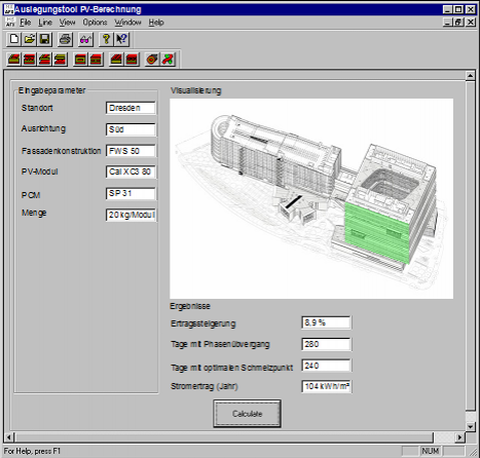PV-Tool
Table of contents
Basic data
| Status | completed |
|---|---|
| Funding source | Federal Ministry for Economic Affairs and Climate Action (abbreviated BMWK former BMWi) |
| Funding reference number | ZF4441803HF8 |
| Duration | 2019 - 2021 |
Summary
With a view to achieving a virtually climate-neutral building stock by 2050, the development and economic application of energy-generating components are a major field of activity in the construction industry. At present, photovoltaic (PV) modules are the most commonly used. By combining them with latent heat storage (PCM), the performance of PV can be increased, especially in warm facades. The aim of the project is to develop a design tool for the variable use of PCM in buildings with PV facades. This will allow the quantity as well as the composition of the PCM to be individually adapted to the respective façade orientation, geographical location and use of the building at an early stage of the project in order to achieve maximum performance enhancement. Embedding the tool in a building simulation program also allows the influence of the PCM on the overall energy demand of the building to be taken into account. In addition, a modular façade system with scalable encapsulations (containers for PCM) is being developed to integrate the required amount of PCM into the façade depending on the application.
Partners
- Institut for Building Climatology - TU Dresden
- Institut of Building Construction, Faculty of Civil Engineering
- Pazdera AG, Coburg
- Solarenergiesysteme Sachsen Ltd.
Project progress
"Application catalog and requirements" (WP1): Compilation of a catalog of possible applications for a calculation tool, definition of resulting boundary conditions on the energy-generating facades equipped with PCM. "Development and production of test stands" (WP2): The calculation algorithm of the design tool should represent all physical processes in the energy generating facade with PCM. To ensure realistic results and successful marketing, the simulation calculations must be validated. This will be done by means of comparative measurements in the open field (development and production of façade test stands with different module orientations at different locations). "Monitoring test stands" (WP 3): Develop measurement concept, data acquisition, data evaluation and simultaneous provision of the data basis for the creation of a design standard "Development of design tool" (WP 4) for energy-generating facades with PCM (analysis of the functions, development of calculation algorithm for linking the individual physical models behind the functions, creation of a visual interface for the user of the design tool, validation of the calculation algorithm) "Development of modulable facade system" (WP 5), which can be used to respond to different module dimensions and PCM layer thicknesses. "Component tests on the modulatable facade system" (WP 6): Testing under laboratory conditions to ensure functionality as well as durability of the design under different climate scenarios. "Integration in building simulation program" (WP 7): In addition to the effect of increasing the electricity yield of the PV modules, PCM integration has an impact on the heating and cooling requirements of the entire building, since the heat flows in the façade are significantly influenced by the temperature of the PCM. These dynamic processes can be calculated in detail and at a high, usually hourly, resolution using a dynamic thermal building simulation depending on the boundary conditions from location and use. For this purpose, the algorithms for energy-generating facade panels with PCM are integrated into a dynamic thermal building simulation program. The building simulation platform NANDRAD is used for the implementation AP 8 Project coordination and reports The IBK works on the areas of computational representation of physical processes and integration into building simulation, in particular Elaboration of an application catalog and the requirements for the PV tool, integration of calculation models into the PV tool and the building simulation solver NANDRAD, definition of data management and administration for monitoring as well as measurement data for calibration of the simulation results with the measurement results, development and implementation of the calculation processes and algorithms for integration into the respective planning tools, Creation and application of validation scenarios for a good stability as well as a fast execution of the programs, development of test stands with PV-PCM façade panels for the use at different locations and under variation of different parameters for the later validation of the calculation tools.
Project coordination
 © Dirk Weiß
© Dirk Weiß
Research assistant
NameDipl.-Ing. Dirk Weiss
Send encrypted email via the SecureMail portal (for TUD external users only).

